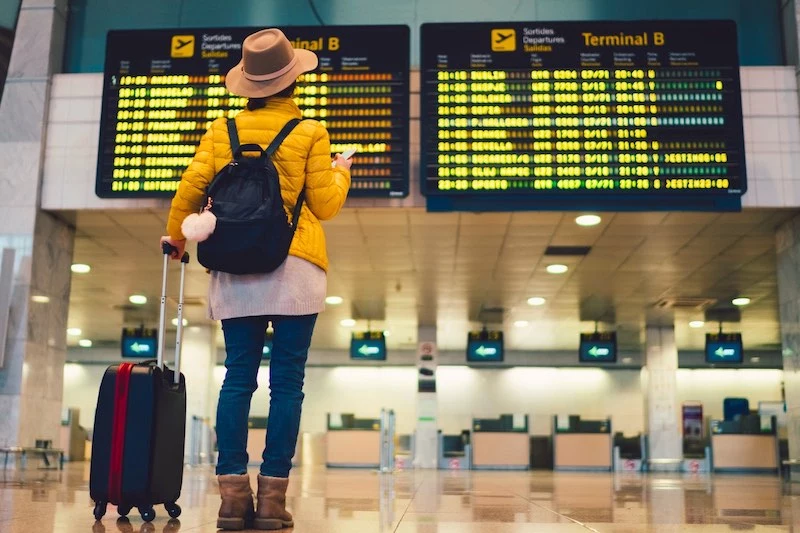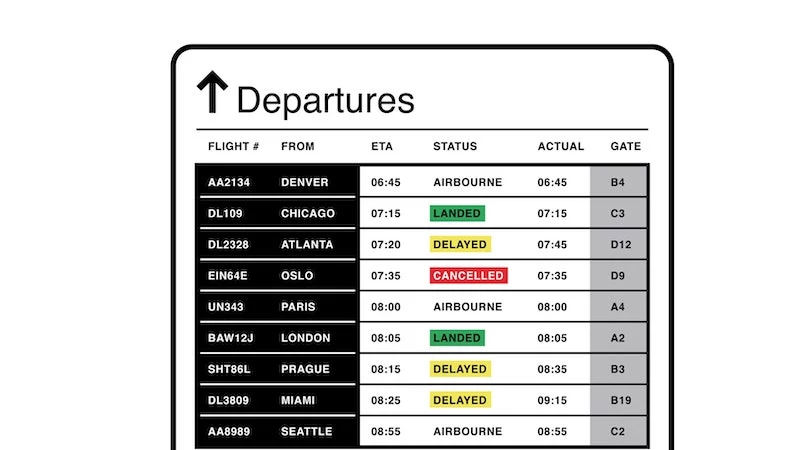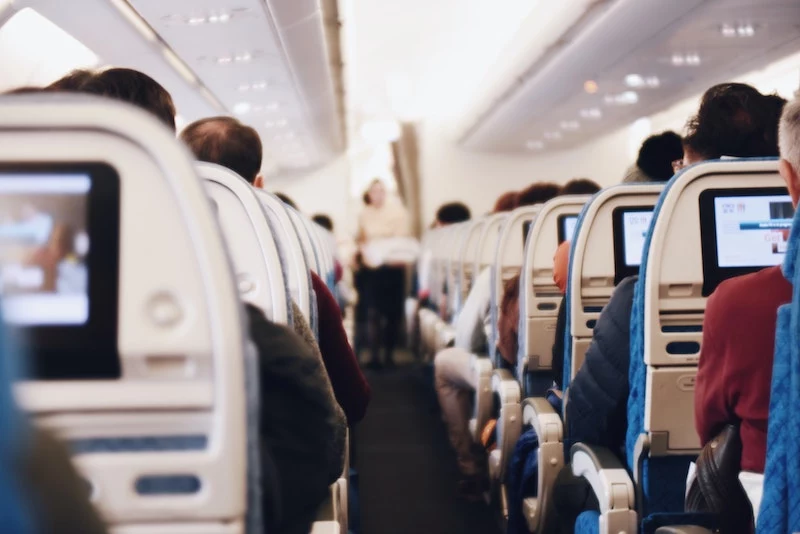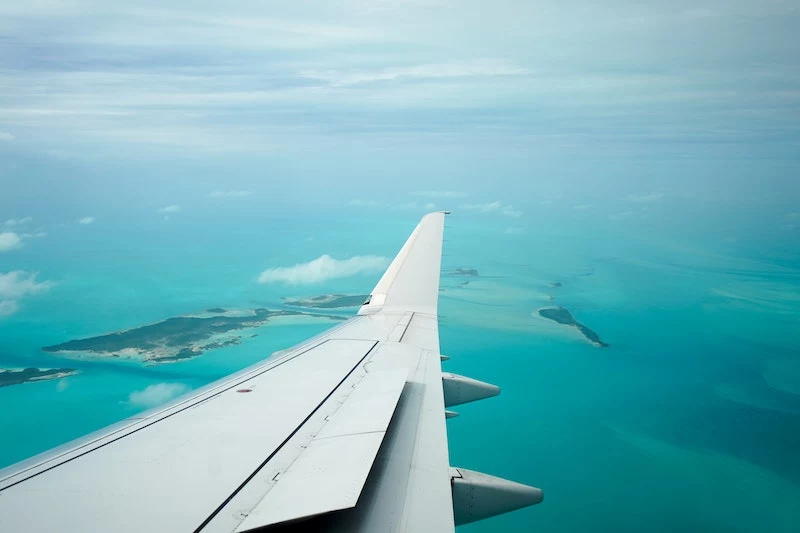Flight Cancelled? Don’t Panic. Here’s the Game Plan the Pros Use.
I can still feel the cold floor of the Frankfurt Airport. It was 2 a.m., my flight home was gone, and a single, overwhelmed agent was staring down a line of two hundred exhausted travelers. People around me were a mix of confused, frustrated, and just plain angry. But honestly? I’ve been there before. As someone who’s spent years on the road for both work and fun, I knew the drill.
In this article
While everyone else was just waiting in that massive line, I was already on my phone. Within minutes, I was rebooked on a partner airline for the next morning, hotel voucher confirmed. This isn’t about getting lucky; it’s about having a solid, practical plan ready to go when things inevitably go sideways.
Let’s be real: flight disruptions are one of the worst parts of travel. They can derail a vacation or mess up a critical business trip, and that feeling of losing control is awful. This guide is here to hand that control right back to you. It’s not just a list of boring rules. It’s a playbook I’ve built from years of experience—a step-by-step method for turning a travel nightmare into a manageable hiccup.

The First 60 Minutes: Your Immediate Action Plan
The second you hear that dreaded announcement—”delayed” or “cancelled”—the clock starts ticking. What you do in the next hour is absolutely critical. Speed and information are your best friends here, while most people just stand around waiting for instructions. Don’t be one of them.
1. Start the Dual-Track Attack.
Whatever you do, don’t just get in that ridiculously long customer service line at the gate. You need to do two things at once. Yes, get in the line. But while you’re standing there, pull out your phone and call the airline’s main customer service number. The agents on the phone often have the same power as the gate agents, but here’s the kicker: they don’t have a line of angry people staring them down. I’ve been rebooked and on my way to a hotel bar before the person at the front of the physical line has even finished explaining their problem.

Pro tip: If you have any kind of elite status with the airline, use their dedicated phone line. The number is usually on the back of your card or in the app. These calls get answered way faster by agents who are often more experienced.
2. Break the Run-Around Loop.
Heads up! Sometimes you’ll get caught in a frustrating loop: the phone agent tells you to talk to the gate agent, who then tells you to call the phone line. It’s designed to make you give up. To break this cycle, be specific. Tell the phone agent, “The gate agent, [describe them briefly, e.g., ‘the man with the glasses at gate C22’], advised me that only phone agents can process rebookings for partner airlines. Can you please assist?” This shows you’re not just being passed along and often gives them the justification they need to take action.
3. Find Your Own Solutions.
Don’t wait for the airline to spoon-feed you options. They’ll likely offer the path of least resistance for them, not the best one for you. Open Google Flights or an app like FlightAware and start searching for other flights to your destination. Check your airline and its partners. When you finally get an agent on the line, you’re in the driver’s seat. Instead of a weak, “What can you do for me?” you can say, “My flight 456 to Denver was cancelled. I see you have two seats on flight 789 tonight. Can you please move me to that one?” This changes everything. You’re bringing them a solution, not just a problem.

4. Get the Reason. In Writing, if Possible.
Politely but firmly ask the agent for the specific reason for the delay or cancellation. “Operational difficulties” is too vague. Is it a “mechanical issue”? A “crewing problem”? “Air traffic control restrictions”? The reason is everything because it determines what you’re entitled to later. A mechanical problem is the airline’s fault. Bad weather usually isn’t. This little piece of information is your golden ticket if you need to file a claim.
Why Flights Actually Get Delayed
It helps to know what’s going on behind the curtain. These aren’t just excuses; they’re usually tied to complex logistics and non-negotiable safety rules.
Mechanical & Technical Stuff
A modern plane is an incredibly complex beast. A “technical issue” could be anything from a faulty sensor to a problem with cabin pressure. Every aircraft has what’s called a Minimum Equipment List (MEL), a safety document approved by aviation authorities. It lists which parts can be broken while the plane is still 100% safe to fly. If the busted component isn’t on that list, the plane is grounded by law until it’s fixed. And sometimes, that fix requires a special part or a certified mechanic who isn’t at your tiny regional airport.

Crew ‘Timing Out’
This one is a huge cause of cancellations, especially after a long delay. Flight crews have strict legal limits on how long they can work and how much rest they need. For instance, a pilot might only be allowed to fly for 8 or 9 hours in a 24-hour period before needing a mandatory 10-hour rest break. If a weather delay stretches their duty day too long, they legally “time out.” They can’t fly, period. It’s a critical safety rule, and finding a replacement crew on short notice can be next to impossible.
The Weather Domino Effect
Weather is more than just a storm at your airport. A single thunderstorm over the Midwest can snarl traffic across the entire country as Air Traffic Control puts a “ground stop” on all flights going through that area. Other things can cause issues, too. Extreme heat, for example, makes the air less dense, meaning wings generate less lift. A heavy plane might need a longer runway than is available, or it might be too heavy to take off at all. It’s all physics.
Rotational Delays
This is the classic cascade. A single airplane is often scheduled to fly multiple routes in one day—say, New York to Chicago, then Chicago to Denver, then Denver to L.A. If that first flight out of New York gets delayed by two hours, every single flight that plane was supposed to make that day will now be at least two hours late. It’s a chain reaction.
Know Your Rights: The USA vs. Europe Showdown
Your passenger rights depend entirely on where you are in the world. To be frank, the rules in Europe are fantastic for travelers. In the United States… not so much. Knowing the difference is key.
Flying in Europe? You Have Superpowers (EC 261)
The EU has a powerful regulation, often called EC 261, that is one of the strongest passenger-rights laws out there. I’ve used it many times to get both care and cash.
Who’s Covered?
It applies if your flight is:
- Departing from any airport in the EU (plus Iceland, Norway, and Switzerland), no matter the airline.
- Arriving at an EU airport, as long as you’re on an EU-based airline (like Lufthansa, Air France, etc.).
Your Right to Care
If you’re stuck with a significant delay, the airline legally owes you a “duty of care.” This isn’t just a nice gesture. They must provide you with:
- Meals and drinks (usually given as vouchers).
- Hotel accommodation for overnight delays.
- Transportation to and from that hotel.
- The ability to make a couple of phone calls or send emails.
Your Right to Cold, Hard Cash
This is the big one. If your flight is cancelled or arrives at your destination more than three hours late for a reason within the airline’s control (like most technical issues or crewing problems), you are entitled to cash compensation. The amount is fixed based on flight distance:
- €250 for short flights (under 1,500 km).
- €400 for medium-haul flights.
- €600 (about $650) for long-haul flights (over 3,500 km).
Airlines will often try to offer you a travel voucher instead, sometimes for a higher amount. Think twice. A voucher has restrictions and an expiration date. Cash is cash.
Flying in the U.S.? You Need to Self-Advocate
In the United States, the rules are much weaker, and airlines have a lot more wiggle room. You have to be your own best advocate.
The Golden Rule: Refunds for Cancellations
This is the most important thing to know: If an airline cancels your flight for any reason and you choose not to travel, you are legally entitled to a full cash refund for your ticket. They will almost certainly offer you a flight credit or voucher first because it keeps your money in their pocket. You must be firm. I’ve had to say this exact phrase: “I am aware of the Department of Transportation’s rule on refunds for cancelled flights. I am declining the travel credit and requesting a full refund to my original form of payment.”
What About Delays?
For delays, there is no federal law that requires airlines to compensate you. It’s all up to the individual airline’s policy, which is buried in their “Contract of Carriage.” Most major airlines will offer a hotel voucher for an overnight delay they caused (like a mechanical issue), but not for weather. But they aren’t required to by law.
The Tarmac Delay Rule
There is one strict rule: airlines can’t hold you on a plane on the tarmac for more than three hours for domestic flights (four for international) without letting you get off. They also have to provide food and water after two hours. This rule exists because passengers used to get trapped for ages without basic amenities.
Getting Paid: Filing a Claim
Once you’re home, it’s time to follow up. You can either do it yourself or use a service.
The DIY Approach
I always start here, especially for clear-cut European cases. Keep all your documents: boarding passes, emails from the airline, and receipts for any food or hotels you had to buy. To file:
- Find the “customer relations” or “claims” form on the airline’s website.
- Write a simple, factual email. No long, angry stories. Just the facts.
- State your name, flight number, and booking reference.
- Clearly state why you’re claiming. For example: “My flight was delayed over 4 hours on arrival due to a technical issue. Per EC 261, I am entitled to €600 in compensation.”
- Attach your documents. If they deny you unfairly, you can appeal. You can find the relevant national enforcement body by searching online for “EU National Enforcement Body Air Passenger Rights.” For US issues, you can file a complaint directly with the Department of Transportation via their website.
Using a Claims Service
Companies that specialize in air passenger rights can handle the whole process for you. It’s a good option if you’re short on time or the airline is stonewalling you. The downside? They take a hefty cut, usually 25% to 35% of your payout. So for a €600 claim, you could be giving away over €200. My advice? Always try the DIY method first.
Pro-Level Travel Hacks
Connecting Flights vs. Separate Tickets
Be very careful here. If you book a single trip (NYC to Rome via Paris on one ticket), the airline has to get you to Rome, even if a delay makes you miss your connection. But if you book separate tickets (one NYC to Paris, another from Paris to Rome), you’re on your own. If your first flight is late, the second airline just sees you as a no-show and will cancel your ticket with no refund. Only do this if you have a massive layover, like 5+ hours or even overnight.
When to Go Rogue and Book Your Own Flight
This is a power move. Let’s say your flight is cancelled and the airline’s only offer is a flight two days from now. That’s not going to work. You can tell the airline you are rejecting their rebooking offer and are requesting a full refund for the original cancelled flight. Then, you can book a new, last-minute ticket on a different airline. This is where good travel insurance shines. For example, your new ticket might cost $600. You get a $400 refund from your original airline, and your travel insurance’s trip interruption coverage could cover the $200 difference. It might cost you nothing out of pocket to save your trip.
Your Best Defense is a Good Offense
The best way to deal with a disruption is to be prepared before you even leave the house.
Book Smarter
- Avoid the last flight of the day. If it’s cancelled, you’re stuck overnight.
- Choose morning flights. They are less likely to be affected by rotational delays that build up during the day.
- Consider the airport. Flying through a massive, efficient hub often gives you more rebooking options than a small regional airport.
Unlock Your Secret Weapon: Credit Card Perks & Insurance
I never travel without a good travel insurance policy. For the price of a fancy airport dinner—maybe $50 to $100 for a two-week trip—you get total peace of mind. A ‘good’ policy has solid Trip Delay coverage that kicks in after a reasonable time (say, 6 hours) and covers hotel, food, and transport up to a decent limit, like $500.
But wait, you might already have coverage! Many premium travel credit cards (like the popular Sapphire or Platinum series) have these benefits built-in. People are sitting on free hotel nights and meal reimbursements and don’t even know it.
Here’s your challenge: After you read this, pull out the credit card you use for travel. Google its name plus “guide to benefits” and find the section on “Trip Delay Reimbursement.” You might be shocked at what you’re already covered for.
Pack a “Go-Bag” in Your Carry-On
Always assume you might get stuck. Your carry-on is your 24-hour survival kit. Always, always pack:
- All your essential medications (plus a few extra days’ worth).
- A portable power bank. Outlets are like gold during a mass delay.
- A change of underwear and a fresh shirt. You’ll thank me later.
- Basic toiletries. Quick tip: Pack solid toiletries, like shampoo bars and toothpaste tabs. They save space and you’ll never have issues with liquid limits.
- A refillable water bottle and some snacks.
- A paper copy of your key documents. Don’t rely on a dead phone.
Look, dealing with a flight disruption is never fun. But with the right knowledge and a plan, you can shift from feeling frustrated and helpless to being in control. Stay calm, be polite but firm, and know your rights. You’re not just a victim of the system; you’re an informed traveler ready to get where you need to go.
Inspirational Gallery
What’s the most powerful tool in your travel wallet?
It’s likely the credit card you used to book your flight. Premium cards like the Chase Sapphire Reserve or The Platinum Card from American Express come with robust travel insurance as a built-in perk. If your flight is delayed over a certain number of hours (usually 6 or 12), you can be reimbursed for reasonable expenses like meals, toiletries, and even a hotel room—often up to $500 per ticket. You don’t need to beg the airline for a voucher; you just pay, keep the receipts, and file a claim later. It’s the ultimate backup plan.
Just 2% of eligible passengers in the U.S. actually receive the cash compensation they’re owed for significant delays or cancellations.
This staggering statistic from consumer advocacy groups highlights a major gap: travelers don’t know their rights. For flights touching Europe, regulation EU261 can entitle you to up to €600 cash, separate from any refund. In the U.S., rules are murkier but you’re always entitled to a refund for a cancelled flight if you choose not to travel. Don’t leave money on the table. Use services like AirHelp to check your eligibility and handle the paperwork for you.
- A quiet space to think and work.
- Reliable, high-speed Wi-Fi.
- Complimentary food and drinks.
- Access to dedicated airline agents who can rebook you without a queue.
The secret to this travel nirvana during a cancellation crisis? An airport lounge. Access isn’t just for first-class flyers. Many credit cards offer a Priority Pass membership, giving you entry to over 1,300 lounges worldwide, turning a chaotic terminal into a calm oasis.
The Airline App: Direct, secure, and often the fastest way to accept pre-selected rebooking options. Best for straightforward, one-click solutions.
Twitter/X Public Post: Airlines have dedicated social media teams that are highly motivated to resolve issues publicly. Tag the airline’s official account with your situation (no personal details!) to often get a swift response via Direct Message.
Using both simultaneously can dramatically increase your chances of a quick resolution.
Your phone is dying, the kids are melting down, and you’ve been in line for an hour. The temptation to unload your frustration on the gate agent is huge. Don’t do it. In a sea of angry faces, being the calm, polite, and reasonable passenger makes you memorable. A simple “I know this is a tough situation for you, too” can completely change the dynamic. These agents have a surprising amount of discretion—from better seat assignments to meal vouchers—and they are far more likely to use it for someone who treats them like a human being.
Think like a pro by using the tools they use. While the airline app tells you what the airline wants you to know, an app like ExpertFlyer tells you what the airline knows. For a small subscription fee, you can see real-time seat availability on virtually any flight. When you call the agent, you can say, “I see two available seats on BA flight 282 tomorrow morning.” This shifts the conversation from asking for help to presenting a solution, making their job easier and getting you rebooked faster.
Assume you’ll be stranded, even if just for a few hours. Keep a pre-packed “disruption kit” in a separate pouch in your carry-on. This isn’t your main toiletry bag; it’s your emergency stash.
- A powerful and fully charged portable power bank (Anker is a reliable choice).
- Solid toiletries: a toothbrush, toothpaste, deodorant, and face wipes.
- Any essential medication for the next 24 hours.
- A spare pair of socks and underwear.
- A protein bar or other non-perishable snack.
Know the difference: a delay vs. a cancellation. A delay is a waiting game; a cancellation means your travel contract is broken.
Once you’re rebooked for the next day, shift your mindset from “stranded” to “bonus layover.” An unexpected night in a new city can be an adventure, not a disaster. Use an app like HotelTonight to snag a great last-minute deal on a cool hotel. Drop your bags, find a highly-rated local restaurant, and turn a travel nightmare into a memorable story. You can’t control the cancellation, but you can control your reaction to it.
Your smartphone’s camera is your best friend. Before you even speak to an agent, take a clear photo of your boarding pass and baggage claim tickets. Throughout the process, screenshot any new flight confirmations, app notifications, or messages from the airline. If you have to buy food or a hotel room, snap a picture of every single receipt immediately. This digital paper trail is gold when you file for reimbursement from your credit card or a service like AirHelp later.










